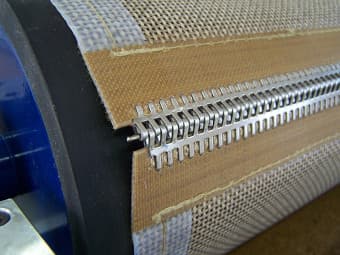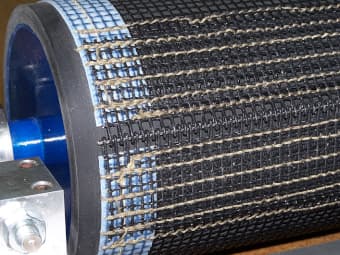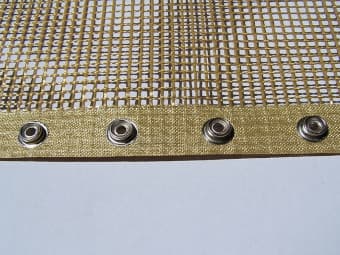PTFE Drying Belts
PTFE drying belts are made of glass, Kevlar or combined mesh fabric. They are coated with Teflon (PTFE) and joined in an endless conveyor belt in different ways and with different types of joints.
In addition, the belts may have reinforced or stitched edges, overlapped joints, guides or other accessories.

Belt Construction

- Glass or Kevlar mesh fabric
- Teflon coating
Typical Applications
PTFE drying belts are designed for use in special applications where a breathable, highly heat-resistant, non-stick or hygienically clean surface is required.
They are most often used in dryers, packaging machines, in the food industry – in bakeries, chocolate factories, freezers, but also in the automotive industry and other industries.
Belt Joints
Proper belt running is only possible if we choose a suitable joint. We must take into account the following factors:
- Fabric type and thickness depending on the application
- Belt load
- Belt tension, roller diameter depending on the requirements of the surface structure
| Joint Type | Description | Illustration |
|---|---|---|
Anker G Hook Clips |
Most common. Metal hooks are pressed into the ends of the belt, so that the belt can be joined into an endless one with a metal bar. It is possible to make sure that the hooks do not protrude above the surface of the belt. Suitable for belts with higher stress. |
 |
Anker A Hook Clips |
With round hooks. Metal hooks are pressed into the ends of the belt, so that the belt can be joined into an endless one with a metal bar. It is possible to make sure that the hooks do not protrude above the surface of the belt. Suitable for belts with higher stress. |
 |
Peek Spiral Joint |
A special plastic spiral is attached to the ends of the belt and the belt can be joined in place to an endless one with a plastic bar. Suitable for lighter joints, the spiral does not protrude above the surface of the tape and does not cause damage to the products. |
 |
Bull Nose Joint |
There are special eyelets at the end of the belt and the belt can be connected in place to an endless one with a plastic bar. Suitable for lighter joints, the spiral does not protrude above the surface of the tape and does not cause damage to the products. |
 |
Castellated Joint |
At both ends, loops of aramid or fiberglass foil are formed, which fit together and the belt can be joined in place with a plastic bar. Suitable for lighter joints, the spiral does not protrude above the surface of the belt and does not cause damage to the products. |
 |
Joint with Kevlar Eyelets |
There are special Kevlar eyelets at the end of the belt and the belt can be connected in place to an endless one with a special bar. Especially due to the high temperature resistance suitable for joints where it is not possible to use metal or plastic clips. |
 |
Overlapping mechanical joints can also be made to protect the material being transported or to protect the joint itself. The cover is made of foil, which is welded to one edge of the belt and when joining the belt together it covers the entire mechanical joint.
Edge Reinforcement

The edges of the conveyor belts can be edged or reinforced with various materials to prevent damage to the belt, cracking of the edges.
The edges can be made of different materials, in some cases the edges can be stitched.
Reinforcement of the belt edges with a welded PTFE fabric is necessary in the following cases.
- In heavier operation, when it is necessary to protect the edge of the belt or to increase the tensile strength.
- When using mesh fabric for transport purposes (drying belts).
- When using side guides and stud guides.
It is recommended to use double-sided edge reinforcement to achieve proper operation with large belt widths.
Belt Guiding
In some cases, it is necessary to ensure the longitudinal guide of the belts. There are several ways to provide that. Each of them has its advantages and limitations.
| Guiding Type | Description | Illustration |
|---|---|---|
Metal Studs |
Guide with metal studs on the edge of the belt. A groove is made on the conveyor roller, into which the studs fit and ensure the guidance of the belt. Simple and cheap solution, suitable for belt speeds up to 20 m/min. The studs can be of different sizes and diameters. |
 |
Metal Eyelets |
Guide with metal eyelets on the edge of the belt. The metal eyelets are attached to the chain carriers with springs. |
 |
PTFE Studs with Pins |
PTFE guide pins are attached with studs to the reinforcement on the belt side. A groove is made on the conveyor roller, into which the studs fit and ensure the guidance of the belt. This guiding type is resistant up to 260 °C. |  |
Kevlar Cord |
Kevlar cord of various sizes is attached by stitching on the edge of the belt. It is an alternative to wedge guides for common types of conveyor belts. A groove is made on the conveyor roller, into which the cord fits and ensures the belt guide. |  |
Questions about This Belt Category?
Don’t hesitate to contact us with any questions about products in this category.




